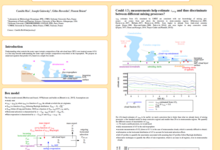Controls on the water vapor isotopic composition near the surface of tropical oceans and role of boundary layer mixing processes

Understanding what controls the water vapor isotopic composition of the sub-loud layer (SCL) over tropical oceans (δD0) is a first step towards understanding the water vapor isotopic composition everywhere in the troposphere. We propose a steady-state analytical model to predict δD0 as a function of sea surface conditions, humidity and temperature profiles, and the altitude from which the free tropospheric air originates (zorig). To do so, we extend previous studies by (1) prescribing the shape of δD vertical profiles, and (2) linking δD0 to zorig . The model relies on the hypothesis that δD profiles are steeper than mixing lines, we neglect the effects of rain evaporation and horizontal advection on δD0 , and the steady-state assumption restricts the application of this model to time sales longer than daily. We show that δD0 does not depend on the intensity of entrainment, dampening hope that δD0 measurements could help constrain this long-searched quantity. Based on an isotope-enabled general circulation model simulation, we show that δD0 variations are mainly controlled by mid-tropospheric depletion and rain evaporation in ascending regions, and by sea surface temperature and zorig in subsiding regions. When the air mixing into the SCL is lower in altitude, it is generally moister, and thus it depletes more efficiently the SCL. In turn, could δD0 measurements help estimate zorig and thus discriminate between different mixing processes? Estimates that are accurate enough to be useful would be difficult to achieve in practice, requiring measuring daily δD profiles, and measuring δD0 with an accuracy of 0.1 % and 0.4 % in trade-wind cumulus and strato-cumulus clouds respectively.
